We drove up to Estes Park where the annual Scandinavian Midsummer Festival was being held. It is the largest midsummer festival in Colorado.
Scandinavians celebrate the summer solstice with flowers, food and music to honor the rejuvenation of life. It is a day when the spirits of nature join the human community to rejoice in the long days of summer. Many of the customs and rituals are associated with the hope for a good harvest in autumn.
We arrived just as the Scandinavian Fashion Show was starting. It was a competition between the men and the women of who had the 'best' outfits.

Strutting their stuff! All of the outfits were authentic or handmade.


Beautiful embroidery!

The powerful Viking
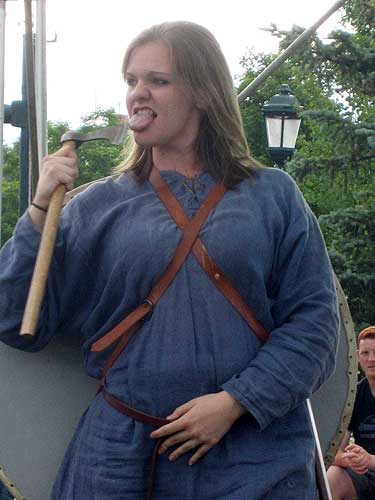
Fierce competition!

Victory! The women won with the loudest applause!
In the center of the field was a traditional Viking encampment, created by the Colorado Fjellborg Viking Reenactor Society. This "living history" group portrays the Scandinavian people and those they affected during the classical Viking age from 793 - 1088. As a result, anyone we talked with was highly knowledgeable of the history and customs of the old culture.

Viking ships varied in style but generally they were slender, flexible boats with symmetrical ends (which meant it could reverse direction quickly without having to turn around).
Since Scandinavia is a region with relatively high and dangerous inland mountain ranges, Vikings lived on the coast and were highly dependent on the North Sea for survival and development. Hence the ship was an integral part of their of culture, not only in terms of practicality but also in religion. Chieftains and noblemen were commonly buried with a ship and even the earliest coins have ships as emblems. Being such skilled ship builders, the Vikings soon had the most powerful and advanced naval vessels of the era. They explored the Baltic Sea, Iceland, Greenland, Newfoundland, the Mediterranean, the Black Sea and even Africa.

The figureheads on Viking ships could have served a variety of purposes: 1) to scare enemies; 2) to ward off evil spirits; 3) to indicate the name of the ship in a non-literate society.

A traditional tent

Typical food, with lots of nuts, fruits and berries


This woman explained her outfit was that of a rich Christian. The clues would be: her hat (pagans didn't generally wear head coverings), her expensive linen underskirt, the patterned material of her dress, the embroidery work, the linen edging, and the fancy broaches. Unfortunately, this is just her best guess since there are almost no surviving examples or written descriptions (and any illustrations were HIGHLY stylized or hidden under shawls). For example, if a grave was discovered, the material would long be gone but the positions of the broaches on the skeleton might give a clue as to how they held the clothing up.
The Christianization of Scandinavia took place between the 8th and 12th centuries. We know very little about the pagan practices of the people before then. They didn't build temples; they didn't write down stories; it wasn't formalized; they didn't even have a name for their religion until they came into contact with outsiders. Our knowledge of Norse religion mostly comes from archaeological discoveries, traditional stories (which were finally written down in Iceland in the 13th century by Snorri Sturluson... who added his own touches, of course) and written records of foreigners (frequently in Arabic, one of the older written languages).
The Vikings came into contact with Christianity through their raids and when they settled in lands with a Christian population. In many of these places, the two religions blended... creating such things as the Christmas tree. It is often believed that the Vikings hated the Christians. This probably wasn't the case. Their attacks more likely had to do more with the fact that the churches and monasteries were typically both wealthy and poorly defended, making them an easy target.

Most Viking drinking horns were probably from domestic cattle.
The Fjellborg Vikings group then did several combat performances. It opened with a warrior capturing a maiden from another group and her kith and kin coming to rescue her.

A warrior proclaims his might in front of a maypole.
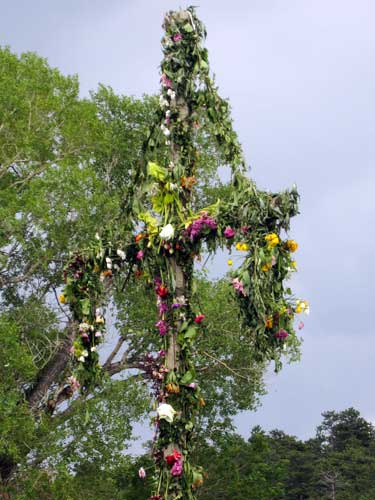
Many Germanic European festivals center around a maypole. The pole's origin is a mystery, although some think its symbolism is connected with the pagan reverence for sacred trees.

Carrying off the maiden...

... and the battle begins!
There were several different fight scenes reenacted. One involved using an axe against a sword; a 'last man standing' competition, and other such events. Throughout the combat, the warriors hurled epithets at each other, the most amusing one being "Your father died of old age!"... which would indeed be an insult where death in battle was considered the only honorable way to go (not unlike 'dying with your boots on' in Colorado's cowboy culture!)

Axe vs sword. There were advantages and disadvantages to each weapon. An axe is heftier and more awkward than a sword but will have greater force if you land a hit.

A fatal blow!
The Viking shield is a VERY effective defense. A shield does not stop the shock of the blow but rather redistributes it over a larger area, making it possible for the human body to absorb the force with reduced risk of injury. While the shield can be moved rapidly to ward off blows coming in from a variety of directions, studies of skeletal remains show that many battle injuries occurred to the head and leg.
The shield was the most common means of defence. Many people think of it as simply a wall to hide behind. While it can be used that way, a more aggressive use is advantageous. Attacks can be deflected well before they reach the body. Sometime the attacking weapon could get stuck in the shield after a blow, but with a twist of his shield, a warrior could either break the weapon or rip it from the grip of its owner.
Viking shields were round, not kite-shaped (which may have evolved for mounted fighting but gave poor protection of an infantryman's legs). The shields eventually grew larger over the centuries. They were made from lighter woods that didn't split, such as linden and fir. It was probably rimmed with leather to keep it from splitting when hit on edge. The shield was gripped from the inside; the arm did not slip through any straps, and as a result, the shield could be rotated freely from side to side. At the center was a domed iron boss, which protected the hand.

A monk converts some pagan warriors to Christianity...

... who then go out and fight for the cause...

... but obviously not very well for the monk pays the price!
Next came the Scandinavian Folk Dancers of Phoenix. What a wonderful performance! They were lively, fun, energetic and extremely entertaining! The dances are from Norway, Sweden and Iceland.

Lots of skilled choreography!



You do have to wonder, though, who originally came up with the idea for some of these moves!

This was a cute dance between two men who were competing for the affections of one woman. But the men were so involved with their dance, that they never noticed a third man move in to try to steal her away. In the end, however, the woman didn't chose any of them but ran off with a girlfriend instead!
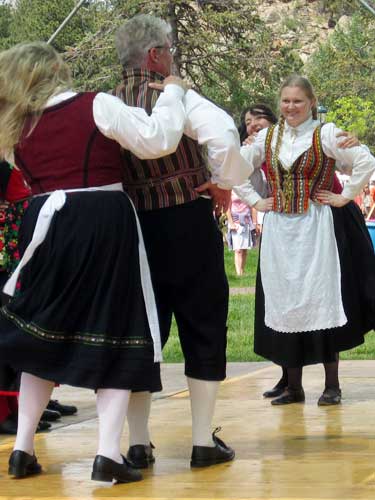
All of the dances had specific names. This one was translated for us as "Peek-a-boo"... and it was obvious to see why.

Wonderful outfits!

Very stylish!
We returned to the encampment and took our time admiring the various weapons, armor and domestic tools.
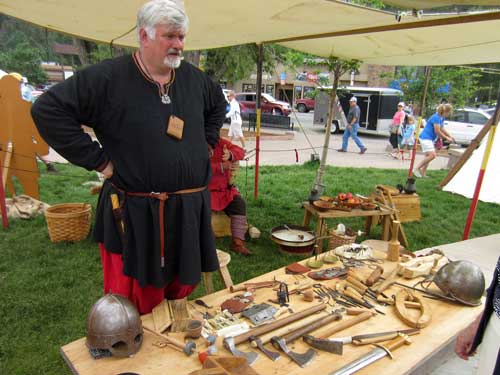

Lots of items were carved from bone.
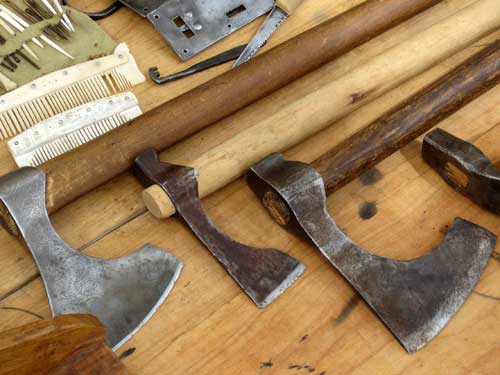

Locks and keys
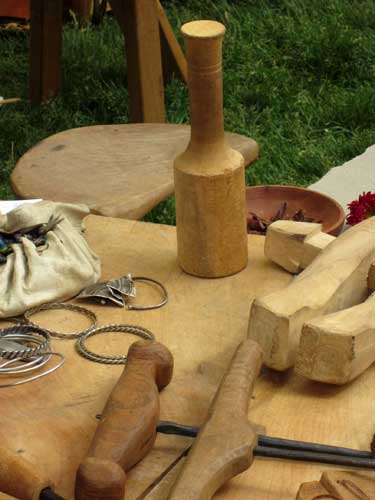
Every good kitchen needs something heavy to pound sauerkraut with!

This is a type pan flute. Each hole is a different depth... which naturally produces a different sound. The letters carved on the flute (which we are actually looking at upside-down) are EGILL, a popular old Norse name.

A demonstration of a bone flute

This is a lyre. The lyre is an ancient Greek string instrument originally made from a tortoiseshell and two cow horns. However, the Scandinavians didn't have any big turtles walking about so they made theirs of wood. Although evidence seems to suggest they didn't copy the instrument but rather that it emerged independently. Different tones can be made from a single string by pressing the fingernail against various points along the string (like a guitar fret).
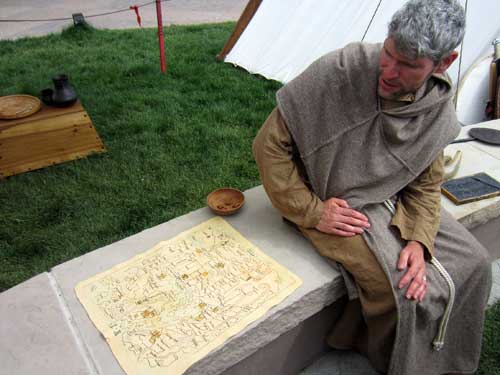
A monk sits overlooking a map. Throughout most of Europe, it was mainly the monks who could read and write.

Click on the map for a larger view
Eventually it was time to head home... but not before one last embarrassing shot of us as Vikings!
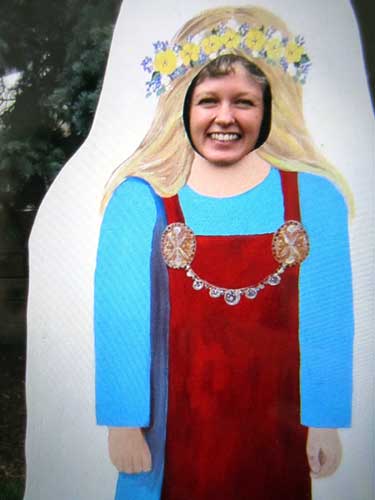
The apron dress was specifically Norse in design. The folks down in Greece were still wearing two sheets clipped together and wrapped around themselves.

Bill looks FAR more impressive than I do!
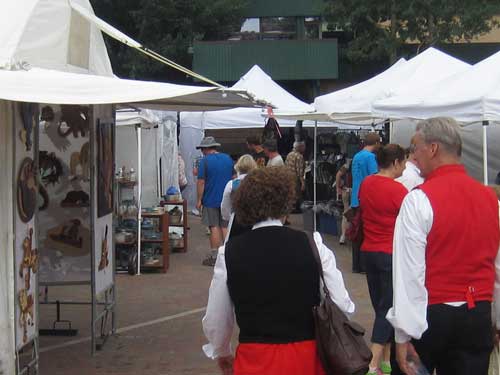
Heading out past the many booths packed with food, jewelry and other wonderful things.